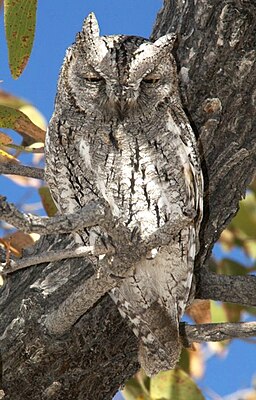Africa scops owl
| Africa scops owl | ||||||||||
|---|---|---|---|---|---|---|---|---|---|---|

African scops owl ( Otus senegalensis ) |
||||||||||
| Systematics | ||||||||||
|
||||||||||
| Scientific name | ||||||||||
| Otus senegalensis | ||||||||||
| ( Swainson , 1837) |
The African scops owl ( Otus senegalensis ) is a bird from the species-rich, ancient genus of the scops owl . It is one of the smallest owls found in Africa. It used to be assigned to the scops owl found north of the Sahara as a subspecies.
features
The African Scops Owl reaches a size of 16 to 19 cm, a weight of 45 to 100 g and a wing length of 117 to 144 mm. The plumage is colored bark-like gray to brown with light inclusions, the feather ears are pronounced, but can be laid out. The legs are feathered to the base of the gray to brown toes, the beak is dark horn-colored and the eyes have a yellow iris. As with most owl species, the females of the African scops owl are on average significantly heavier than the males.
The African scops owl is not dissimilar to the slightly larger scops owl, which occurs as a wintering guest in the northern part of the distribution area , but can be clearly distinguished from it by its call.
voice
The call of the African scops owl is a monosyllabic "Prürr" that lasts about 0.5 to 1 second and is repeated after 5 to 8 seconds.
habitat
The habitat of the African scops owl is formed by tree and shrub-lined savannahs and dry, open forests, and in the vicinity of human settlements it also likes to stay in gardens and parks. In contrast, it does not occur in densely forested regions and above 2000 m.
Distribution and occurrence
The African scops owl occurs in sub-Saharan Africa to the Cape region in areas that offer it the appropriate habitat, and is quite common in its range.
Subspecies
The species is divided into three subspecies:
- O. s. senegalensis - Almost the entire range.
- O. s. nivosus - southeastern Kenya .
- O. s. feae - Annobón Island near Equatorial Guinea.
food
Mainly insects, but also spiders, scorpions, small mammals, reptiles and amphibians are the food of the African scops owl. It usually hunts from a hide, but it can also catch insects from the air.
Behavior and reproduction
The African scops owl is predominantly crepuscular and nocturnal. During the day, it rests hidden in the thick foliage, well camouflaged on trunks or thick branches or in tree hollows. Pairs sometimes rest in the immediate vicinity, and the birds occasionally form small colonies during the day.
The African scops owl leads a lifelong monogamous marriage. During the courtship season, the couples occasionally call in a duet. The female usually lays 2 to 4 white eggs in a brood cavity, which it incubates on its own while the male feeds it. The young hatch after about 27 days and can fledge after about another 30 days. The branchlings are then provided with food by both parents for around 40 days.
literature
- T. Carnaby: Beat about the Bush - Birds. Jacana Media, 2008, ISBN 978-1-77009-241-9 .
- H. Chittenden, G. Upfold: Roberts Bird Guide. John Voelcker Bird Book Fund, 2007, ISBN 978-0-620-38313-4 .
- H. Mikkola: Handbook owls of the world. Franckh-Kosmos Verlag, 2013, ISBN 978-3-440-13275-3 .
- I. Sinclair, P. Hockey, W. Tarboton, P. Ryan: Birds of Southern Africa. Struik Nature, 2011, ISBN 978-1-77007-925-0 .
Individual evidence
- ^ [1] Avibase - The world bird database
- ↑ [2] http://www.avibirds.com/html/owls/African_Scops_Owl.html
Web links
- Otus senegalensis in the endangered Red List species the IUCN 2014 Posted by: BirdLife International, 2014. Accessed June 23, 2016th
- Videos, photos and sound recordings of Otus senegalensis in the Internet Bird Collection